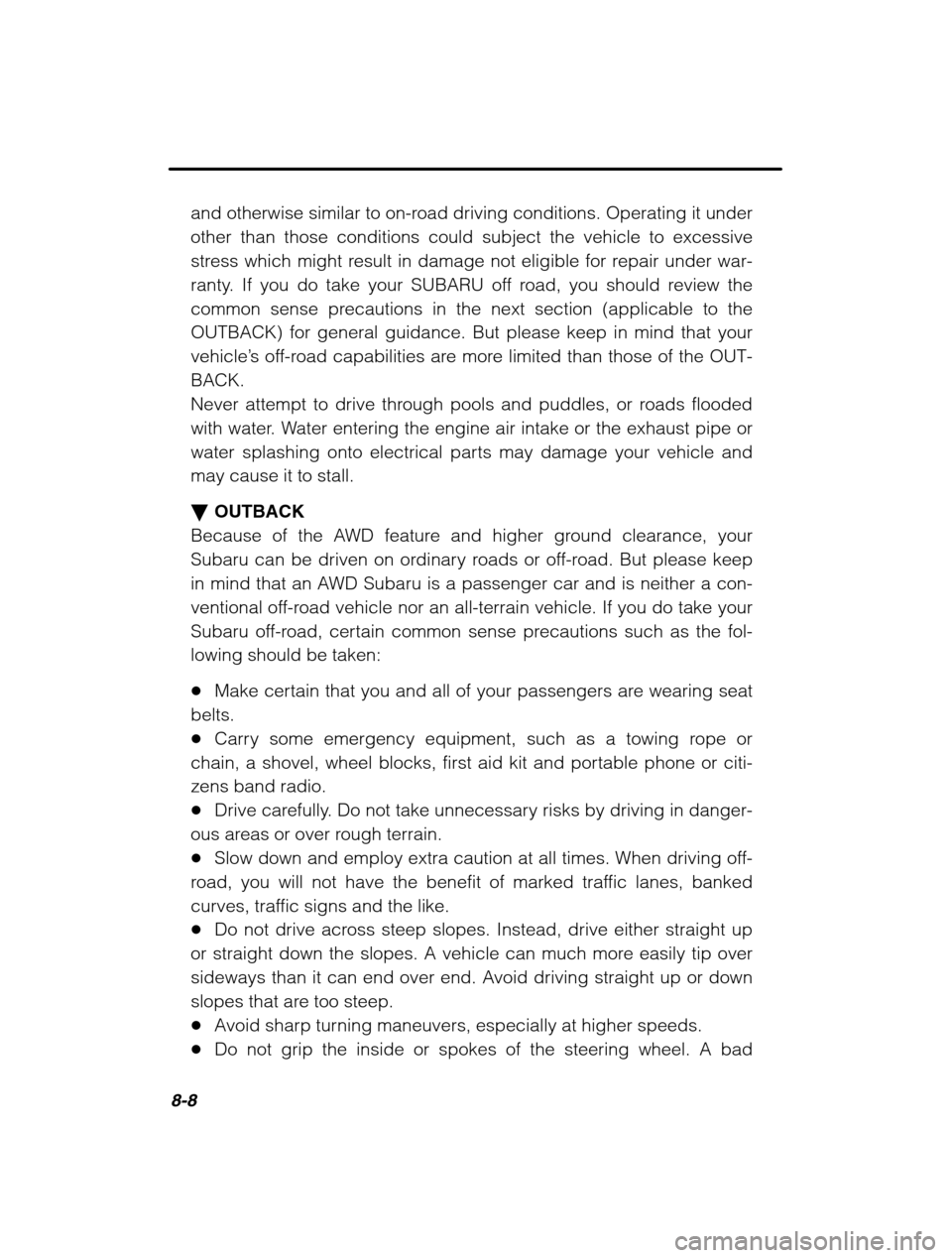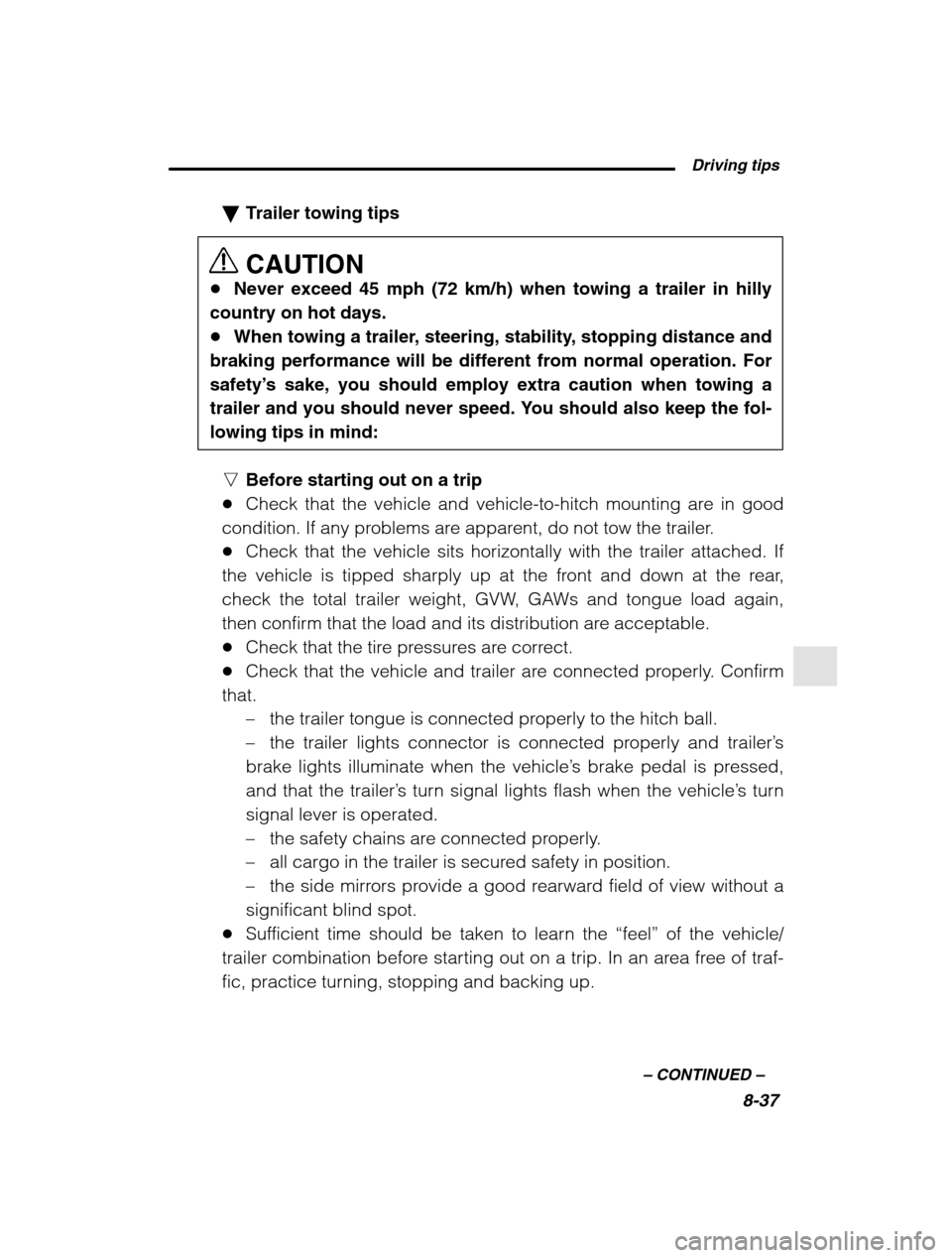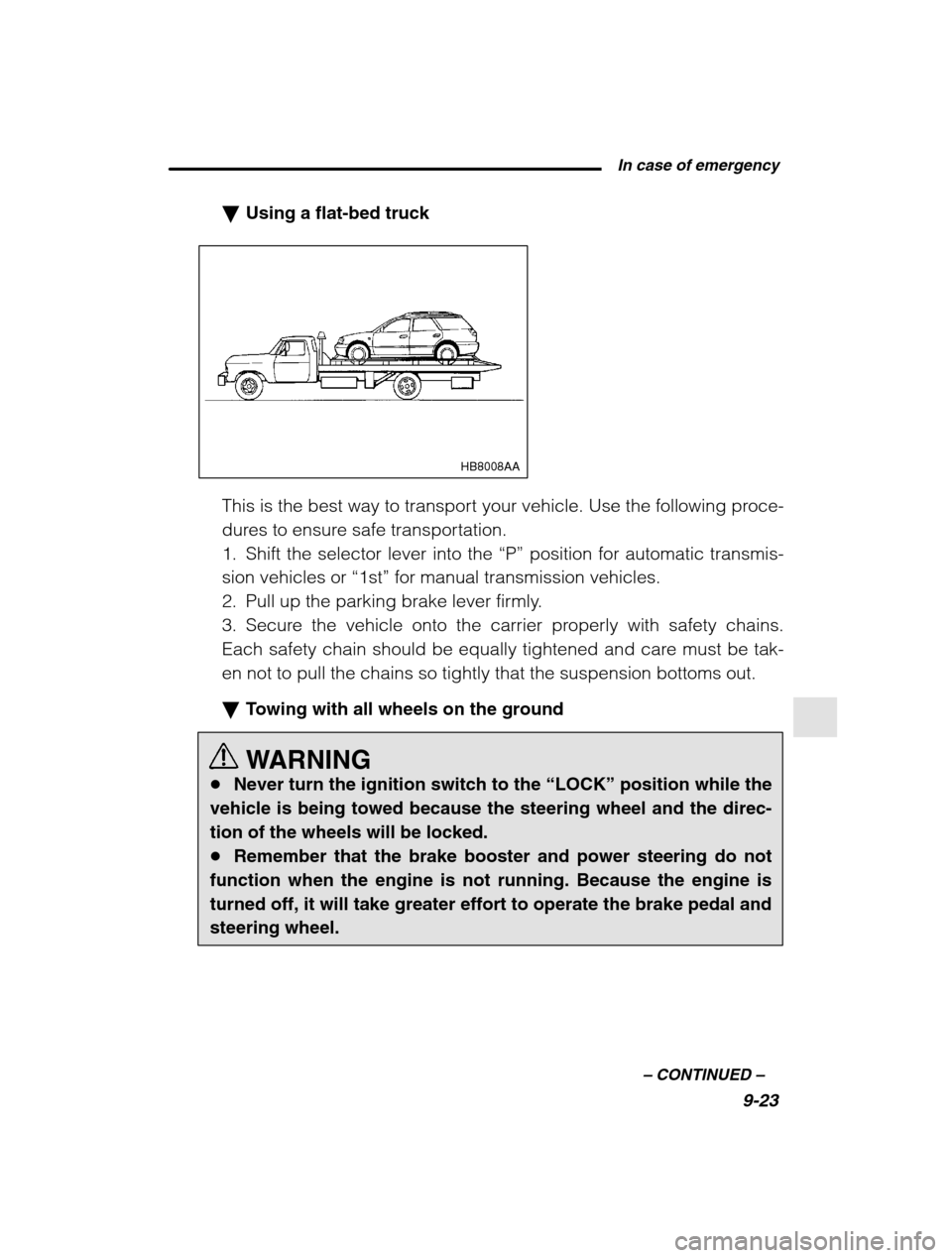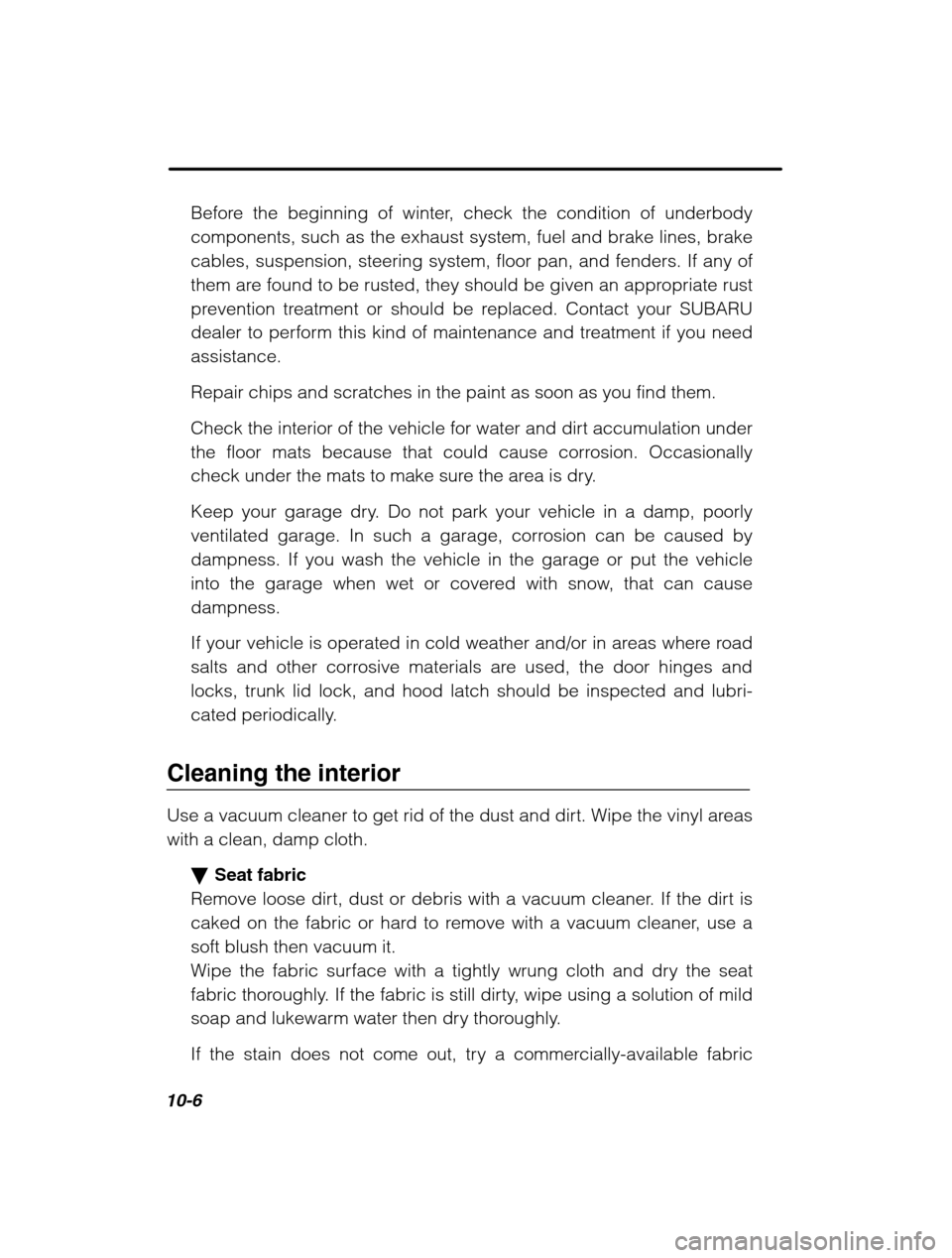2002 SUBARU FORESTER steering
[x] Cancel search: steeringPage 304 of 466

8-8
and otherwise similar to on-road driving conditions. Operating it under other than those conditions could subject the vehicle to excessive
stress which might result in damage not eligible for repair under war-
ranty. If you do take your SUBARU off road, you should review the
common sense precautions in the next section (applicable to the
OUTBACK) for general guidance. But please keep in mind that your
vehicle’s off-road capabilities are more limited than those of the OUT-
BACK.
Never attempt to drive through pools and puddles, or roads flooded
with water. Water entering the engine air intake or the exhaust pipe or
water splashing onto electrical parts may damage your vehicle andmay cause it to stall. � OUTBACK
Because of the AWD feature and higher ground clearance, your
Subaru can be driven on ordinary roads or off-road. But please keep
in mind that an AWD Subaru is a passenger car and is neither a con-
ventional off-road vehicle nor an all-terrain vehicle. If you do take your
Subaru off-road, certain common sense precautions such as the fol-lowing should be taken: � Make certain that you and all of your passengers are wearing seat
belts. � Carry some emergency equipment, such as a towing rope or
chain, a shovel, wheel blocks, first aid kit and portable phone or citi-zens band radio.� Drive carefully. Do not take unnecessary risks by driving in danger-
ous areas or over rough terrain.� Slow down and employ extra caution at all times. When driving off-
road, you will not have the benefit of marked traffic lanes, banked
curves, traffic signs and the like.� Do not drive across steep slopes. Instead, drive either straight up
or straight down the slopes. A vehicle can much more easily tip over
sideways than it can end over end. Avoid driving straight up or down
slopes that are too steep.� Avoid sharp turning maneuvers, especially at higher speeds.
� Do not grip the inside or spokes of the steering wheel. A bad
Page 307 of 466

Driving tips8-11
–
CONTINUED –
Keep the door locks from freezing by squirting them with deicer or glycerin.
Forcing a frozen door open may damage or separate the rubber
weather strips around the door. If the door is frozen, use hot water to
melt the ice, and afterwards thoroughly wipe the water away.
Use a windshield washer fluid that contains an antifreeze solution. Do
not use engine antifreeze or other substitutes because they may dam-age the paint of the vehicle. nBefore driving your vehicle
Before entering the vehicle, remove any snow or ice from your shoes
because that could make the pedals slippery and dangerous.
While warming up the vehicle before driving, check that the accelera-
tor pedal, brake pedal, and all other controls operate smoothly.
Clear away ice and snow that has accumulated under the fenders to
avoid making steering difficult. During severe winter driving, stop
when and where it is safe to do so and check under the fenders peri-
odically. n Parking in cold weather
WARNING
Snow can trap dangerous exhaust gases under your vehicle. Keep snow clear of the exhaust pipe and from around your
vehicle if you park the vehicle in snow with the engine running.
Do not use the parking brake when parking for long periods in cold
weather since it could freeze in that position. Instead, observe the fol-lowing:
1. Place the shift lever in “1” or “R” for manual transmission vehicles,
and in “P” for automatic transmission vehicles.
2. Use tire stops under the tires to prevent the vehicle from moving.
When the vehicle is parked in snow or when it snows, raise the wiper
blades off the glass to prevent damage to them.
Page 333 of 466

Driving tips8-37
–
CONTINUED –
�Trailer towing tips CAUTION
� Never exceed 45 mph (72 km/h) when towing a trailer in hilly
country on hot days. � When towing a trailer, steering, stability, stopping distance and
braking performance will be different from normal operation. For
safety’ s sake, you should employ extra caution when towing a
trailer and you should never speed. You should also keep the fol-lowing tips in mind:
n Before starting out on a trip
� Check that the vehicle and vehicle-to-hitch mounting are in good
condition. If any problems are apparent, do not tow the trailer.� Check that the vehicle sits horizontally with the trailer attached. If
the vehicle is tipped sharply up at the front and down at the rear,
check the total trailer weight, GVW, GAWs and tongue load again,
then confirm that the load and its distribution are acceptable.� Check that the tire pressures are correct.
� Check that the vehicle and trailer are connected properly. Confirm
that. –the trailer tongue is connected properly to the hitch ball.
– the trailer lights connector is connected properly and trailer ’s
brake lights illuminate when the vehicle ’s brake pedal is pressed,
and that the trailer ’s turn signal lights flash when the vehicle ’s turn
signal lever is operated.– the safety chains are connected properly.
– all cargo in the trailer is secured safety in position.
– the side mirrors provide a good rearward field of view without a
significant blind spot.
� Sufficient time should be taken to learn the “feel” of the vehicle/
trailer combination before starting out on a trip. In an area free of traf-
fic, practice turning, stopping and backing up.
Page 334 of 466

8-38
nDriving with a trailer
� You should allow for considerably more stopping distance when
towing a trailer. Avoid sudden braking because it may result in skid-
ding or jackknifing and loss of control.� Avoid abrupt starts and sudden accelerations. If your vehicle has a
manual transmission, always start out in first gear and release the
clutch at moderate engine revolution.� Avoid uneven steering, sharp turns and rapid lane changes.
� Slow down before turning. Make a longer than normal turning
radius because the trailer wheels will be closer than the vehicle
wheels to the inside of the turn. In a tight turn, the trailer could hit yourvehicle.� Crosswinds will adversely affect the handling of your vehicle and
trailer, causing sway. Crosswinds can be due to weather conditions or
the passing of large trucks or buses. If swaying occurs, firmly grip the
steering wheel and slow down immediately but gradually.� When passing other vehicles, considerable distance is required
because of the added weight and length caused by attaching the
trailer to your vehicle.� Backing up with a trailer is difficult and takes practice. When back-
ing up with a trailer, never accelerate or steer rapidly. When turning
back, grip the bottom of the steering wheel with one hand and turn it
to the left for a left turn, and turn it to the right for a right turn.
Left turn Right turn
OM-H2791
� If the ABS warning light illuminates while the vehicle is in motion,
stop towing the trailer and have repairs performed immediately by the
Page 359 of 466

In case of emergency9-23
–
CONTINUED –
�Using a flat-bed truck
HB8008AA
This is the best way to transport your vehicle. Use the following proce-
dures to ensure safe transportation.
1. Shift the selector lever into the “P” position for automatic transmis-
sion vehicles or “1st” for manual transmission vehicles.
2. Pull up the parking brake lever firmly.
3. Secure the vehicle onto the carrier properly with safety chains.
Each safety chain should be equally tightened and care must be tak-en not to pull the chains so tightly that the suspension bottoms out. � Towing with all wheels on the ground
WARNING
� Never turn the ignition switch to the “LOCK” position while the
vehicle is being towed because the steering wheel and the direc- tion of the wheels will be locked.� Remember that the brake booster and power steering do not
function when the engine is not running. Because the engine isturned off, it will take greater effort to operate the brake pedal andsteering wheel.
Page 365 of 466

10-2
Exterior care �Washing
CAUTION
� When washing the vehicle, the brakes may get wet. As a result,
the brake stopping distance will be longer. To dry the brakes, drive the vehicle at a safe speed while lightly pressing the brakepedal to heat up the brakes.� Do not wash the engine compartment and areas adjacent to it.
If water enters the engine air intake, electrical parts or the power
steering fluid reservoir, it will cause engine trouble or faulty
power steering respectively.
The best way to preserve your vehicle ’s beauty is frequent washing.
Wash the vehicle at least once a month to avoid contamination by roadgrime.
Wash dirt off with a wet sponge and plenty of lukewarm or cold water. Do
not wash the vehicle with hot water and in direct sunlight.
Salt, chemicals, insects, tar, soot and bird droppings should be washed
off by using a light detergent, as required. If you use a light detergent,
make certain that it is a neutral detergent. Do not use strong soap or
chemical detergents. All cleaning agents should be promptly flushed
from the surface and not allowed to dry there. Rinse the vehicle thor-
oughly with plenty of lukewarm water. Wipe the remaining water off with a
chamois or soft cloth. NOTE When having your vehicle washed in an automatic car wash, make
sure beforehand that the car wash is of suitable type. If the vehicle
is equipped with a rear/roof spoiler, it may be damaged by car washbrushes or other equipment.
Page 369 of 466

10-6
Before the beginning of winter, check the condition of underbody
components, such as the exhaust system, fuel and brake lines, brake
cables, suspension, steering system, floor pan, and fenders. If any of
them are found to be rusted, they should be given an appropriate rust
prevention treatment or should be replaced. Contact your SUBARU
dealer to perform this kind of maintenance and treatment if you needassistance. Repair chips and scratches in the paint as soon as you find them.
Check the interior of the vehicle for water and dirt accumulation under
the floor mats because that could cause corrosion. Occasionally
check under the mats to make sure the area is dry.
Keep your garage dry. Do not park your vehicle in a damp, poorly
ventilated garage. In such a garage, corrosion can be caused by
dampness. If you wash the vehicle in the garage or put the vehicle
into the garage when wet or covered with snow, that can causedampness.
If your vehicle is operated in cold weather and/or in areas where road
salts and other corrosive materials are used, the door hinges and
locks, trunk lid lock, and hood latch should be inspected and lubri-
cated periodically.
Cleaning the interior
Use a vacuum cleaner to get rid of the dust and dirt. Wipe the vinyl areas with a clean, damp cloth. �Seat fabric
Remove loose dirt, dust or debris with a vacuum cleaner. If the dirt is
caked on the fabric or hard to remove with a vacuum cleaner, use asoft blush then vacuum it.
Wipe the fabric surface with a tightly wrung cloth and dry the seat
fabric thoroughly. If the fabric is still dirty, wipe using a solution of mild
soap and lukewarm water then dry thoroughly.
If the stain does not come out, try a commercially-available fabric
Page 371 of 466

11
Maintenance and service
Maintenance schedule11-3
. . . . . . . . . . . . . . . . . . . . . . . . . . . . . . . . . . . . . . . . . . . . . . . . . .
Maintenance precautions 11-3
. . . . . . . . . . . . . . . . . . . . . . . . . . . . . . . . . . . . . . . . . . . . . .
Engine hood 11-5
. . . . . . . . . . . . . . . . . . . . . . . . . . . . . . . . . . . . . . . . . . . . . . . . . . . . . . . . . . . . . . . .
Engine compartment overview 11-7 . . . . . . . . . . . . . . . . . . . . . . . . . . . . . . . . . . . . . . .
Engine oil 11-9
. . . . . . . . . . . . . . . . . . . . . . . . . . . . . . . . . . . . . . . . . . . . . . . . . . . . . . . . . . . . . . . . . . . .
Cooling system 11-14
. . . . . . . . . . . . . . . . . . . . . . . . . . . . . . . . . . . . . . . . . . . . . . . . . . . . . . . . . . . .
Engine coolant 11-15
. . . . . . . . . . . . . . . . . . . . . . . . . . . . . . . . . . . . . . . . . . . . . . . . . . . . . . . . . . .
Air cleaner element 11-18
. . . . . . . . . . . . . . . . . . . . . . . . . . . . . . . . . . . . . . . . . . . . . . . . . . . . . .
Spark plugs 11-20
. . . . . . . . . . . . . . . . . . . . . . . . . . . . . . . . . . . . . . . . . . . . . . . . . . . . . . . . . . . . . . . . .
Drive belts 11-22
. . . . . . . . . . . . . . . . . . . . . . . . . . . . . . . . . . . . . . . . . . . . . . . . . . . . . . . . . . . . . . . . . . .
Manual transmission oil 11-23
. . . . . . . . . . . . . . . . . . . . . . . . . . . . . . . . . . . . . . . . . . . . . . . .
Automatic transmission fluid 11-24 . . . . . . . . . . . . . . . . . . . . . . . . . . . . . . . . . . . . . . . . .
Front differential gear oil (AT vehicles) 11-26 . . . . . . . . . . . . . . . . . . . . . . . . . . . .
Rear differential gear oil 11-27
. . . . . . . . . . . . . . . . . . . . . . . . . . . . . . . . . . . . . . . . . . . . . . . .
Power steering fluid 11-29
. . . . . . . . . . . . . . . . . . . . . . . . . . . . . . . . . . . . . . . . . . . . . . . . . . . . .
Brake fluid 11-30
. . . . . . . . . . . . . . . . . . . . . . . . . . . . . . . . . . . . . . . . . . . . . . . . . . . . . . . . . . . . . . . . . . .
Clutch fluid (MT vehicles) 11-32 . . . . . . . . . . . . . . . . . . . . . . . . . . . . . . . . . . . . . . . . . . . . . .
Brake booster 11-33
. . . . . . . . . . . . . . . . . . . . . . . . . . . . . . . . . . . . . . . . . . . . . . . . . . . . . . . . . . . . . .
Brake pedal 11-34
. . . . . . . . . . . . . . . . . . . . . . . . . . . . . . . . . . . . . . . . . . . . . . . . . . . . . . . . . . . . . . . . .
Clutch pedal (Manual transmission vehicles) 11-35 . . . . . . . . . . . . . . . . . . .
Replacement of brake pad and lining 11-36 . . . . . . . . . . . . . . . . . . . . . . . . . . . . . .
Parking brake stroke 11-37
. . . . . . . . . . . . . . . . . . . . . . . . . . . . . . . . . . . . . . . . . . . . . . . . . . . .
Tires and wheels 11-38
. . . . . . . . . . . . . . . . . . . . . . . . . . . . . . . . . . . . . . . . . . . . . . . . . . . . . . . . . .
Types of tires 11-38
. . . . . . . . . . . . . . . . . . . . . . . . . . . . . . . . . . . . . . . . . . . . . . . . . . . . . . . . . . . . .
Tire inspection 11-39
. . . . . . . . . . . . . . . . . . . . . . . . . . . . . . . . . . . . . . . . . . . . . . . . . . . . . . . . . . .
Tire pressures and wear 11-39
. . . . . . . . . . . . . . . . . . . . . . . . . . . . . . . . . . . . . . . . . . . . . . . .
Wheel balance 11-42
. . . . . . . . . . . . . . . . . . . . . . . . . . . . . . . . . . . . . . . . . . . . . . . . . . . . . . . . . . . .
Wear indicators 11-43
. . . . . . . . . . . . . . . . . . . . . . . . . . . . . . . . . . . . . . . . . . . . . . . . . . . . . . . . . .
Tire rotation 11-44
. . . . . . . . . . . . . . . . . . . . . . . . . . . . . . . . . . . . . . . . . . . . . . . . . . . . . . . . . . . . . . .
Tire replacement 11-44
. . . . . . . . . . . . . . . . . . . . . . . . . . . . . . . . . . . . . . . . . . . . . . . . . . . . . . . . .
Wheel replacement 11-45
. . . . . . . . . . . . . . . . . . . . . . . . . . . . . . . . . . . . . . . . . . . . . . . . . . . . . .
Wheel covers 11-46
. . . . . . . . . . . . . . . . . . . . . . . . . . . . . . . . . . . . . . . . . . . . . . . . . . . . . . . . . . . . .
Aluminum wheels (If equipped) 11-47 . . . . . . . . . . . . . . . . . . . . . . . . . . . . . . . . . . . . . .
Windshield washer fluid 11-47
. . . . . . . . . . . . . . . . . . . . . . . . . . . . . . . . . . . . . . . . . . . . . . . .
Replacement of windshield wiper blades 11-48 . . . . . . . . . . . . . . . . . . . . . . . .